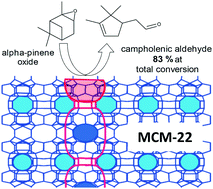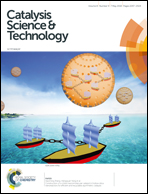α-Pinene oxide isomerization: role of zeolite structure and acidity in the selective synthesis of campholenic aldehyde†
Abstract
MWW-type zeolites with different textural properties, namely, MCM-22, MCM-36, MCM-56, and MCM-49, were synthesized and tested in the selective preparation of campholenic aldehyde by isomerization of α-pinene oxide. Commercial zeolites USY, Beta, and ZSM-5 were compared. The physico-chemical properties of the studied zeolites were correlated with their catalytic performance in the isomerization of α-pinene oxide carried out either in toluene as a solvent at 70 °C or in N,N-dimethylacetamide at 140 °C. α-Pinene oxide isomerizes easily in the presence of acids and therefore, high conversions were achieved over commercial as well as synthesized MWW catalysts. Higher selectivities to campholenic aldehyde were achieved over MWW catalysts in basic N,N-dimethylacetamide while non-basic toluene enhanced the formation of the desired aldehyde over all the commercial zeolites. The highest selectivity to the desired aldehyde was achieved over MCM-22 in the reaction performed in N,N-dimethylacetamide at 140 °C, being 83% at total conversion of α-pinene oxide. This is the best result achieved rivaling homogenous acids (ZnBr2) and metal–organic frameworks.



 Please wait while we load your content...
Please wait while we load your content...